Prediction of Casing Collapse Strength Based on Bayesian Neural Network
Abstract
:1. Introduction
2. Prediction Model Scheme of Casing Collapse Strength Based on Bayesian Regularization Algorithm
Model Construction Scheme
3. Bayesian Regularized Artificial Neural Networks
4. Experimental Data Acquisition
5. Establishment of Bayesian Regularized Neural Network for Prediction Casing Collapse Strength
5.1. Sample Data Pre-Processing
5.2. Define the Network Structure
5.3. Model Training and Optimization
5.4. Model Evaluation and Prediction Result Analysis
6. Conclusions
Author Contributions
Funding
Institutional Review Board Statement
Informed Consent Statement
Data Availability Statement
Conflicts of Interest
References
- Han, J.Z.; Zhang, X.P. Preliminary study on casing collapse strength under non-uniform load. Drill. Technol. 2001, 24, 48–50. [Google Scholar]
- Zhang, R.R.; Yan, Y.F.; Wang, P.; Yan, H.; Yan, X. Quantitative failure risk analysis of shale gas well casing deformation based on Bayesian network. Pet. Drill. Prod. Technol. 2018, 40, 736–742. [Google Scholar]
- Lou, Q.; Zhang, G.L.; Zhang, D.; Han, X.L.; Yang, P.; Zhang, Y. Experimental study on the main influencing factors of casing collapse strength. Pet. Field Mach. 2012, 41, 38–42. [Google Scholar]
- Zhang, X.; Wang, L.; Meng, F.S.; Zheng, Z.C. Research on the application of Bayesian neural network method in casing loss prediction. Prog. Geophys. 2018, 33, 1319–1324. [Google Scholar]
- Zhao, K.N. Distributed Photovoltaic Prediction and Application Based on Bayesian Neural Network; China Electric Power Research Institute: Wales, UK, 2020. [Google Scholar] [CrossRef]
- Xia, S.Y.; Su, J.H.; Du, Y.; Wang, H.N.; Shi, S. PEMFC stack modeling based on Bayesian regularization BP neural network. J. Hefei Univ. Technol. 2021, 44, 5. [Google Scholar]
- Zhao, Y.H.; Jiang, H.Q.; Li, H.Q.; Liu, H.T.; Han, D.W.; Wang, Y.N.; Liu, C.C. Prediction method of single well casing loss based on machine learning. J. China Univ. Pet. 2020. [Google Scholar]
- Zhang, S.R.; Li, X.K. Hidden layer node estimation algorithm of BP network based on simulated annealing. J. Hefei Univ. Technol. 2017, 40, 4. [Google Scholar]
- Tan, C.D.; He, J.Y.; Zhou, T.; Liu, J.K.; Song, W.C. Optimization of shale gas fracturing construction parameters based on PCA-BNN. J. Southwest Pet. Univ. 2020, 42, 7. [Google Scholar]
- Negash, B.M.; Atta, Y.D. Production prediction of waterflooding reservoir based on artificial neural network. Pet. Explor. Dev. 2020, 47, 357–365. [Google Scholar] [CrossRef]
- Negash, B.M.; Vasant, P.M.; Jufar, S.R. Application of artificial neural networks for calibration of a reservoir model. Intell. Decis. Technol. 2018, 12, 67–79. [Google Scholar] [CrossRef]
- Wang, M. Application Research of Neural Network Method in Casing Loss Prediction; Northeast Petroleum University: Daqing, China, 2007. [Google Scholar]
- Li, X.H.; Zhu, H.W.; Chen, G.M.; Lv, H.; Meng, X.K. Bayesian dynamic model for risk analysis of submarine oil and gas pipeline leakage accidents. Chin. Saf. Sci. J. 2015, 25, 75–80. [Google Scholar]
- Pan, Y.C.; Shan, W.B.; Zhang, S.H.; Wang, F. Application of Bayesian Normalization Algorithm in Reservoir Parameter Fitting. Internet Things Technol. 2012, 2, 45–47. [Google Scholar]
- Deng, K.H. Research on Non-Uniform Casing Collapse and Repair Mechanics; Southwest Petroleum University: Chengdu, China, 2018. [Google Scholar]
- Shi, J.; Khan, F.; Zhu, Y.; Li, J.; Chen, G. Robust data-driven model to study dispersion of vapor cloud in offshore facility. Ocean. Eng. 2018, 161, 98–110. [Google Scholar] [CrossRef]
- Shi, J.; Zhu, Y.; Khan, F.; Chen, G. Application of Bayesian Regularization Artificial Neural Network in explosion risk analysis of fixed offshore platform. J. Loss Prev. Process Ind. 2019, 57, 131–141. [Google Scholar] [CrossRef]
- Lin, Y.-h.; Deng, K.-h.; Zeng, D.-z.; Zhu, H.-j.; Zhu, D.-j.; Qi, X.; Huang, Y. Theoretical and experimental analyses of casing collapsing strength under non-uniform loading. J. Cent. South Univ. 2014, 21, 3470–3478. [Google Scholar] [CrossRef]
- Cao, Q. Data driven production forecasting using machine learning. In Proceedings of the SPE Argentina Exploration and Production of Unconventional Resources Symposium, Buenos Aires, Argentina, 1–3 June 2016. [Google Scholar]
- Wang, C.Y. Research and Development of Tubing and Casing Quality Assessment System under Intelligent Manufacturing Environment; Xi’an University of Technology: Xi’an, China, 2018. [Google Scholar]
- Liu, Q.; Li, N.; Shen, Z.-x.; Zhao, M.-f.; Xie, J.-f.; Zhu, G.-c.; Xu, X.; Yin, C.-x. Calculation and experiment of anti-collapse performance of titanium alloy tubing and casing. Nat. Gas Ind. 2020, 40, 94–101. [Google Scholar]
- Xiao, Z.Q.; Jia, L.F.; Wen, C.X.; Zhao, Z.Y.; Jia, S.P. Model and optimization of the collapse strength of casing-cement ring combination under non-uniform ground stress. J. Yangtze Univ. 2020, 17, 39–44. [Google Scholar]
- Jiao, W.; Wang, Q.; Tian, X.J.; Yuan, Q.Y.; Li, X.L.; Gao, C.L. P110 steel grade Φ139.7mm × 10.54mm high collapse resistance performance analysis and collapse strength prediction. Welded Pipe 2017, 40, 20–24. [Google Scholar]
- Miskuf, M.; Michalik, P.; Zolotova, I. Data mining in cloud usage data with Matlab’s statistics and machine learning toolbox. In Proceedings of the IEEE International Symposium on Applied Machine Intelligence & Informatics, Herl’any, Slovakia, 26–28 January 2017. [Google Scholar]
- Mohamadian, N.; Ghorbani, H.; Wood, D.A.; Mehrad, M.; Davoodi, S.; Rashidi, S.; Soleimanian, A.; Shahvand, A.K. A geomechanical approach to casing collapse prediction in oil and gas wells aided by machine learning. J. Pet. Sci. Eng. 2020, 196, 107811. [Google Scholar] [CrossRef]
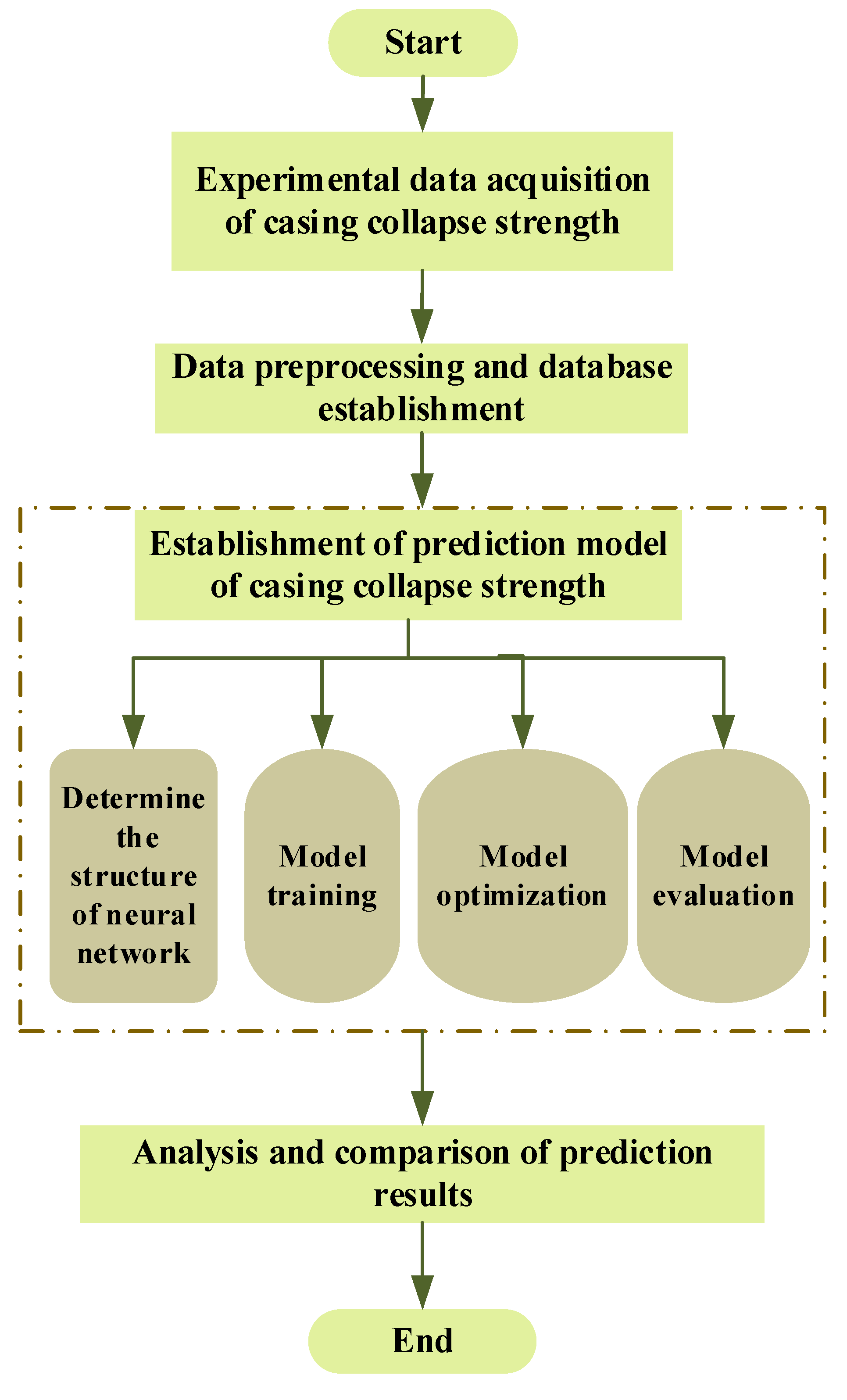
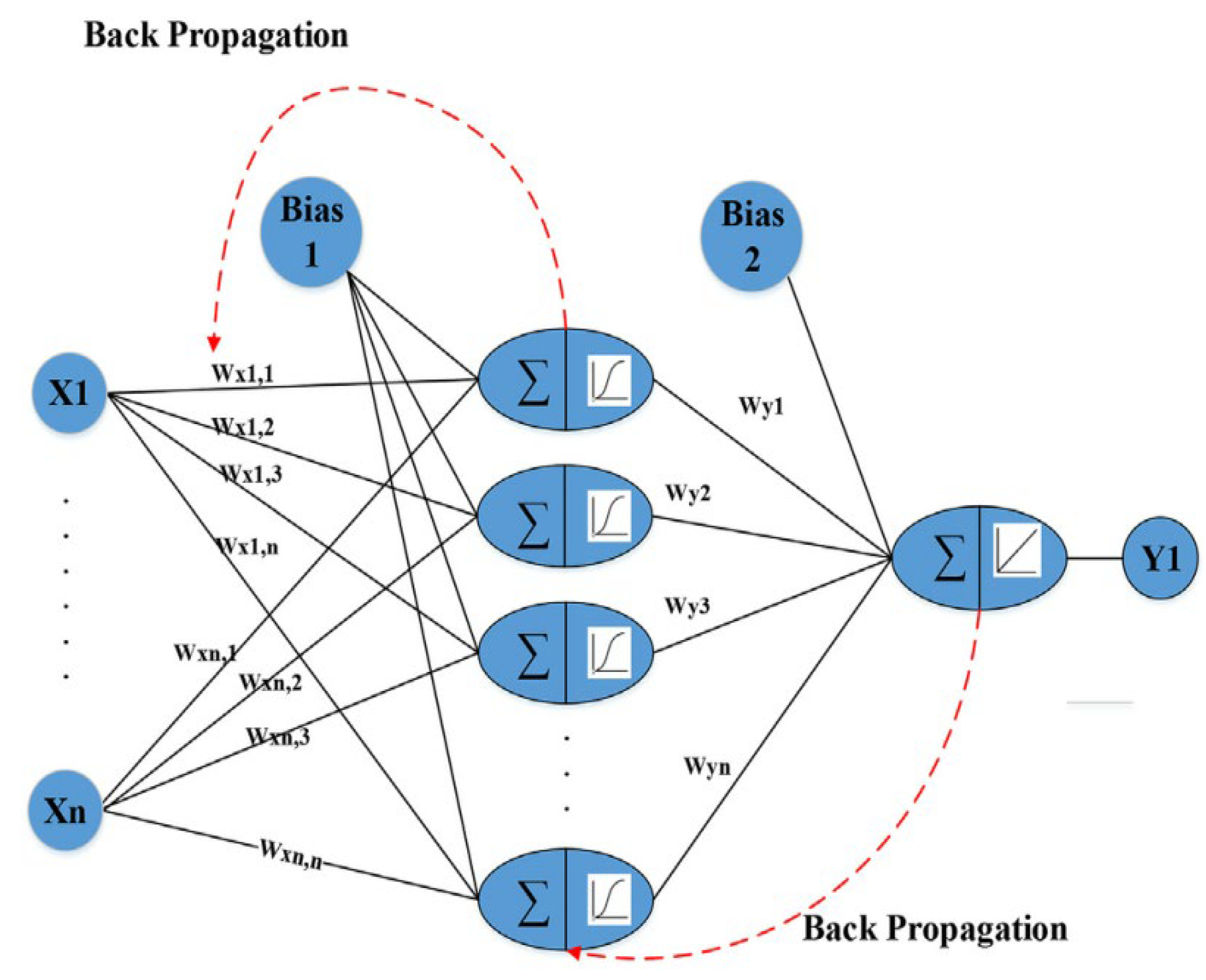



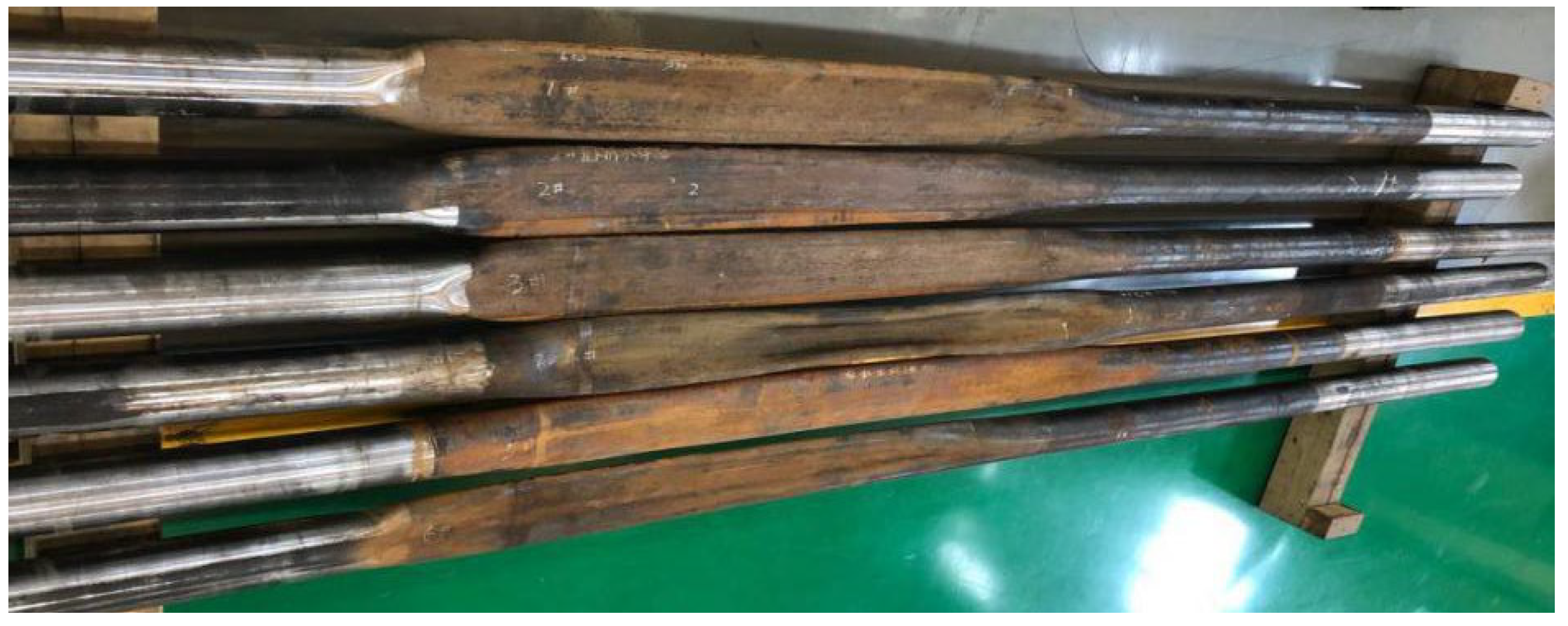


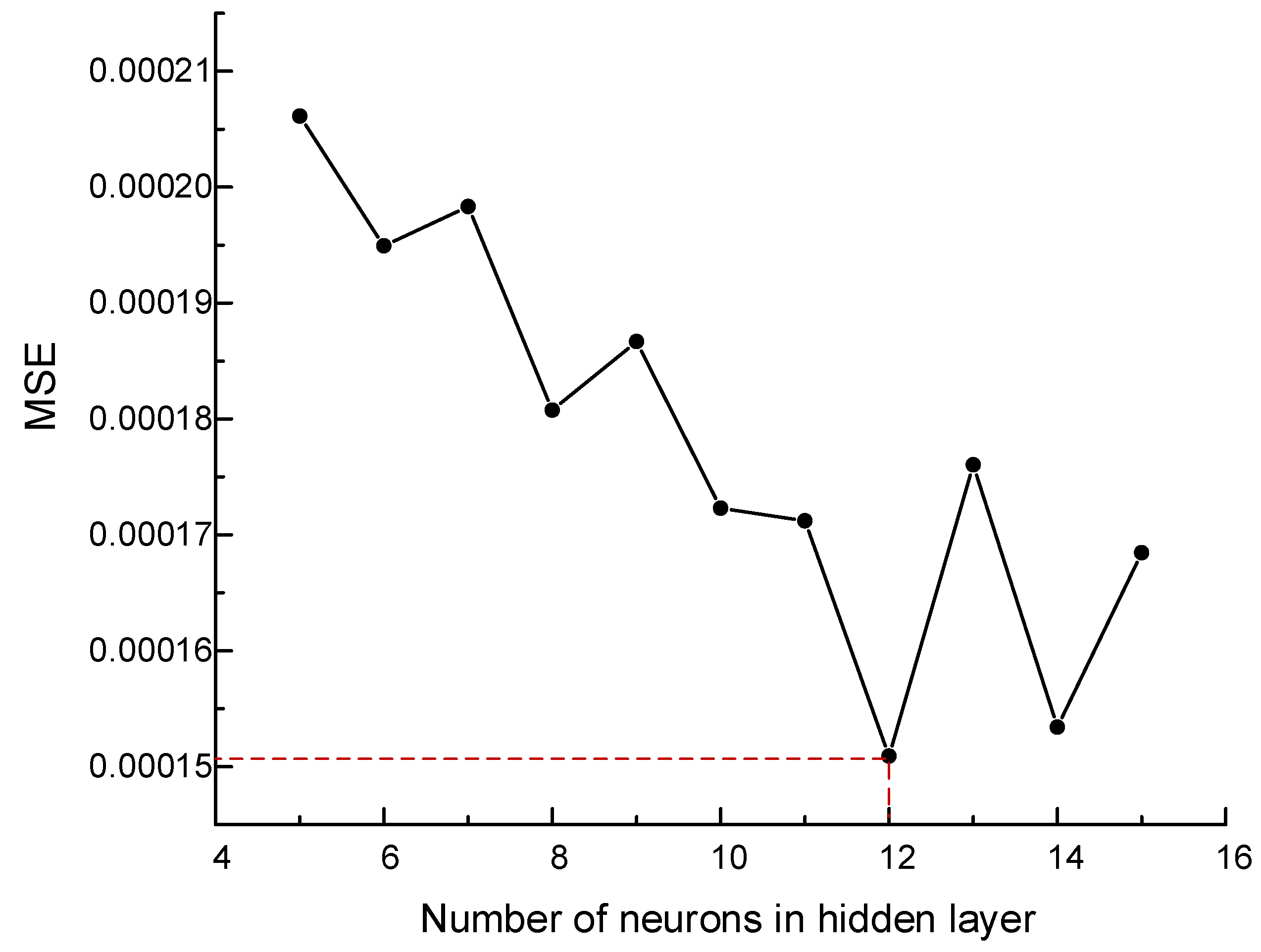

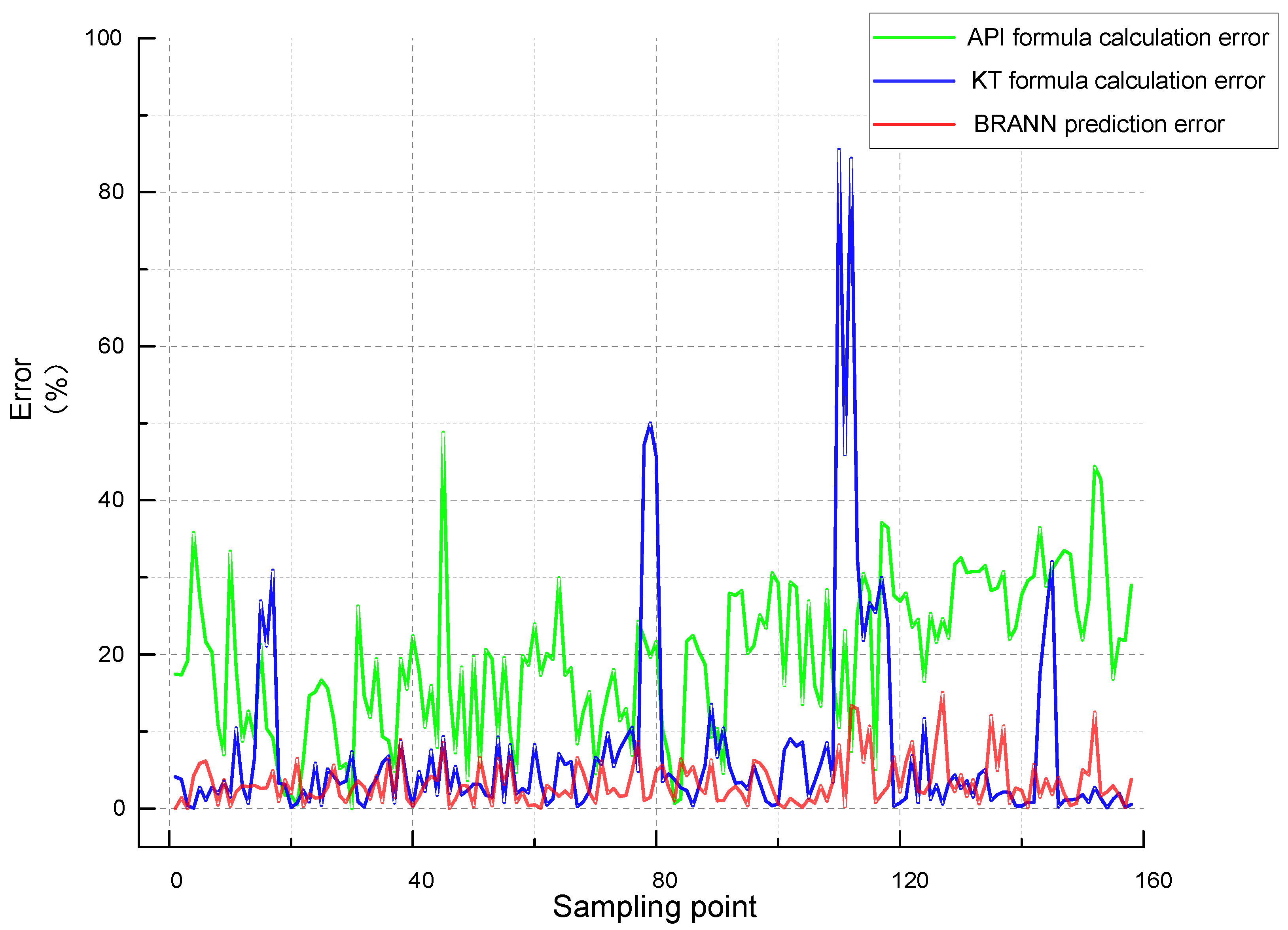
| Measurement section | Average outside diameter | Ellipticity (1) | |||||||
| M1-N1 | G1-H1 | O1-P1 | E1-F1 | ||||||
| 141.58 | 141.18 | 141.07 | 141.17 | 141.25 | 0.36 | ||||
| M1 | N1 | G1 | H1 | O1 | P1 | E1 | F1 | Average wall thickness | Wall thickness unevenness (2) |
| 13.09 | 13.43 | 12.77 | 13.46 | 12.96 | 12.84 | 13.16 | 13.15 | 13.11 | 5.26 |
| Measurement section | Average outside diameter | Ellipticity | |||||||
| M2-N2 | G2-H2 | O2-P2 | E2-F2 | ||||||
| 141.00 | 141.22 | 141.21 | 141.09 | 141.13 | 0.16 | ||||
| M2 | N2 | G2 | H2 | O2 | P2 | E2 | F2 | Average wall thickness | Wall thickness unevenness |
| 13.08 | 13.40 | 12.94 | 13.21 | 12.75 | 12.92 | 12.96 | 13.31 | 13.06 | 4.97 |
| Measurement section | Average outside diameter | Ellipticity | |||||||
| M3-N3 | G3-H3 | O3-P3 | E3-F3 | ||||||
| 141.10 | 141.56 | 141.14 | 141.33 | 141.28 | 0.33 | ||||
| M3 | N3 | G3 | H3 | O3 | P3 | E3 | F3 | Average wall thickness | Wall thickness unevenness |
| 13.00 | 13.34 | 12.71 | 13.22 | 12.60 | 12.86 | 13.15 | 13.03 | 12.99 | 5.71 |
| Measurement section | Average outside diameter | Ellipticity | |||||||
| M4-N4 | G4-H4 | O4-P4 | E4-F4 | ||||||
| 141.01 | 141.16 | 141.19 | 141.01 | 141.09 | 0.13 | ||||
| M4 | N4 | G4 | H4 | O4 | P4 | E4 | F4 | Average wall thickness | Wall thickness unevenness |
| 13.10 | 13.19 | 13.02 | 12.71 | 12.94 | 12.59 | 13.32 | 12.96 | 12.98 | 5.63 |
| Measurement section | Average outside diameter | Ellipticity | |||||||
| M5-N5 | G5-H5 | O5-P5 | E5-F5 | ||||||
| 141.17 | 141.21 | 141.09 | 141.09 | 141.14 | 0.09 | ||||
| M5 | N5 | G5 | H5 | O5 | P5 | E5 | F5 | Average wall thickness | Wall thickness unevenness |
| 13.33 | 13.20 | 12.96 | 12.96 | 13.15 | 12.65 | 13.10 | 13.00 | 13.02 | 5.23 |
| Specimen Number | Location of Measurements | Outer Diameter (mm) | Wall Thickness (mm) | Residual Stress (MPa) | |
|---|---|---|---|---|---|
| B-D (before) | B-D (after) | C | / | ||
| Di (m) | Df (mm) | t (mm) | / | ||
| 1# | 1 | 141.29 | 142.16 | 13.04 | / |
| 2 | 140.90 | 141.65 | 13.40 | / | |
| 3 | 140.92 | 141.85 | 13.15 | / | |
| 4 | 140.90 | 141.78 | 13.06 | / | |
| Average value | 141.00 | 141.86 | 13.16 | 130.57 | |
| Outer Diameter in | Outer Diameter Out-of-Roundness % | Unevenness of Wall Thickness % | Residual Stress Mpa | Yield Strength Mpa | Casing Collapse Strength/psi |
|---|---|---|---|---|---|
| 4.53 | 0.471 | 3.145 | 14.76 | 700.53 | 12,469 |
| 4.51 | 0.416 | 2.356 | 116.92 | 817.06 | 13,550 |
| 4.51 | 0.074 | 4.400 | 225.95 | 661.92 | 13,416 |
| … | … | … | … | … | … |
| 5.53 | 0.37 | 0.643 | 156.86 | 464.03 | 4263 |
| 5.53 | 0.428 | 0.7 | 145.27 | 458.17 | 4160 |
| 5.53 | 0.405 | 0.376 | 153.87 | 468.86 | 4048 |
| … | … | … | … | … | … |
| 7.04 | 0.194 | 2.872 | 62.85 | 498.85 | 5757 |
| 7.05 | 0.192 | 2.304 | 130.21 | 480.92 | 5961 |
| 7.05 | 0.165 | 6.662 | 108.27 | 490.94 | 5400 |
| … | … | … | … | … | … |
| 9.70 | 0.359 | 3.678 | 105.48 | 452.66 | 2689 |
| 9.71 | 0.402 | 1.985 | 35.31 | 645.37 | 5032 |
| 9.71 | 0.401 | 2.781 | 34.83 | 649.509 | 4975 |
| … | … | … | … | … | … |
| 13.47 | 0.368 | 1.987 | 213.31 | 900.00 | 3342 |
| 13.47 | 0.184 | 1.643 | 254.84 | 890.48 | 3316 |
| 13.44 | 0.212 | 1.603 | 172.45 | 886.35 | 3208 |
| … | … | … | … | … | … |
| 16.09 | 0.231 | 2.329 | 31.351 | 721.56 | 2669 |
| 16.08 | 0.291 | 4.723 | 37.79 | 718.45 | 2550 |
| 16.08 | 0.234 | 4.682 | 29.73 | 712.59 | 2413 |
| Number of Neurons in the Hidden Layer | Neural Network Model Training R2-Value | Neural Network Model Predicting R2-Value |
|---|---|---|
| 5 | 0.99699 | 0.99715 |
| 6 | 0.99707 | 0.99730 |
| 7 | 0.99675 | 0.99727 |
| 8 | 0.99689 | 0.99701 |
| 9 | 0.99537 | 0.99774 |
| 10 | 0.99716 | 0.99748 |
| 11 | 0.99684 | 0.99750 |
| 12 | 0.99746 | 0.99780 |
| 13 | 0.99740 | 0.99742 |
| 14 | 0.99712 | 0.99775 |
| 15 | 0.99685 | 0.99754 |
| Tape | Max | Min | Average |
|---|---|---|---|
| API formula | 48.84% | 0.02% | 19.46% |
| The least square improved KT formula | 85.56% | 0.06% | 7.41% |
| BRANN | 15.09% | 0.01% | 3.33% |
Publisher’s Note: MDPI stays neutral with regard to jurisdictional claims in published maps and institutional affiliations. |
© 2022 by the authors. Licensee MDPI, Basel, Switzerland. This article is an open access article distributed under the terms and conditions of the Creative Commons Attribution (CC BY) license (https://creativecommons.org/licenses/by/4.0/).
Share and Cite
Li, D.; Fan, H.; Wang, R.; Yang, S.; Zhao, Y.; Yan, X. Prediction of Casing Collapse Strength Based on Bayesian Neural Network. Processes 2022, 10, 1327. https://doi.org/10.3390/pr10071327
Li D, Fan H, Wang R, Yang S, Zhao Y, Yan X. Prediction of Casing Collapse Strength Based on Bayesian Neural Network. Processes. 2022; 10(7):1327. https://doi.org/10.3390/pr10071327
Chicago/Turabian StyleLi, Dongfeng, Heng Fan, Rui Wang, Shangyu Yang, Yating Zhao, and Xiangzhen Yan. 2022. "Prediction of Casing Collapse Strength Based on Bayesian Neural Network" Processes 10, no. 7: 1327. https://doi.org/10.3390/pr10071327
APA StyleLi, D., Fan, H., Wang, R., Yang, S., Zhao, Y., & Yan, X. (2022). Prediction of Casing Collapse Strength Based on Bayesian Neural Network. Processes, 10(7), 1327. https://doi.org/10.3390/pr10071327







